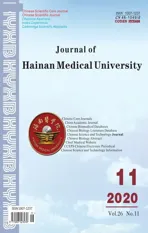Study on novel coronavirus pneumonia (COVID-19) mechanism by Huashi Baidu Formula based on network pharmacology
2020-07-31YuanLiuJinBaoLiuWeiPeng
Yuan Liu, Jin-Bao Liu,2, Wei Peng
1. Shandong University of traditional Chinese medicine, Shandong Jinan 250014, China
2. Affiliated Hospital of Shandong University of traditional Chinese Medicine, Shandong Jinan 250014, China
Keywords:Huashi Baidu Formula Network pharmacology Chinese Medicine COVID-19 SARS-CoV-2
ABSTRACT Objective: To explore novel coronavirus pneumonia (COVID-19) by the method of network pharmacology. Methods: The compounds contained in the Huashi Baidu Formula were searched by TCMSP database, the active components and their action targets were screened, and the proteins were standardized by Uniprot database, and the drug-active ingredienttarget network was constructed by Cytoscape3.7.2 software. The targets related to COVID-19 were screened by GeneCards database. STRING database and DAVID database were used to construct and analyze PPI network, GO analysis and KEGG enrichment analysis(P < 0.05). Results: The "drug-active ingredient-target" network of Huashi Baidu Formula consists of 176 components and 149targets, including AR, ESR1, PTGS2, PPARG, NOS2 and so on. 251 targets related to COVID-19. GO functional enrichment analysis showed that there were 179 biological processes, mainly related to inflammation, regulation of apoptosis and immune response, and 82 KEGG related signaling pathways were obtained, including HIF-1, TNF, small cell lung cancer, non-small cell lung cancer, tuberculosis, PI3K-Akt, NF- κ B, MAPK and so on. Conclusion: Huashi Baidu Formula may regulate the immune and inflammatory response of the body by acting on AR, ESR1, PTGS2, PPARG, NOS2 and other targets, which is the result of multi-component, multi-target and multi-channel interaction.
1. Introduction
In December 2019, COVID-19 (coronavirusdisease-2019,COVID-19) caused by novel coronavirus (SARS-CoV-2) broke out in Wuhan City, Hubei Province. The disease spread rapidly and widely and was highly contagious[1]. As of 15:00 on March 30th, a total of 82463 cases have been confirmed in China and 642278 cases abroad, which has had a serious impact on people's health, economic development and social stability. So far, no specific drugs have been found. Traditional Chinese medicine believes that this disease is an epidemic disease, which belongs to the category of febrile disease, and its pathogenesis is characterized by "dampness, heat, poison, blood stasis and deficiency". Traditional Chinese medicine, including traditional Chinese medicine, has a good therapeutic effect on it[2]. After the outbreak of the epidemic, the third to seventh editions of the "pneumonia diagnosis and treatment Program of novel coronavirus infection (trial)" issued by the National Health Commission recommended the use of traditional Chinese medicine to treat COVID-19[3-7]. Data show that among the confirmed cases of COVID-19 across the country, 74187 people have used traditional Chinese medicine, accounting for 91.5%. Among them, 61449 people in Hubei Province have used traditional Chinese medicine, accounting for 90.6%. Clinical observation shows that the total effective rate of traditional Chinese medicine is more than 90%[8]. Traditional Chinese medicine has once again played an important role in fighting the epidemic, showing unique advantages.
At present, the epidemic situation of COVID-19 in China has initially come to an end. through clinical practice and summary, China has selected Jinhua Qinggan granule, Lianhua Qingwen capsule and Xuebijing injection. as well as Qingfei Paidu decoction, Huashi Baidu prescription, Xuanfei Baidu prescription and other "three prescriptions" with obvious curative effect. Among them, the prescription for resolving dampness and detoxification is optimized by the National Medical team of traditional Chinese Medicine (Chinese Academy of traditional Chinese Medicine) on the basis of the prescription recommended by the national diagnosis and treatment plan, combined with the clinical practice of Jinyintan Hospital in Wuhan. it is suitable for the treatment of mild, ordinary and severe patients. The prescription is composed of ephedra, patchouli, raw gypsum, almond, Pinellia ternata, magnolia, Atractylodes, grass fruit, Poria, astragalus, red peony, scape seed, rhubarb and licorice. It has the functions of detoxification and dampness, clearing heat and relieving asthma, and enhancing immunity. In《COVID-19 's diagnosis and treatment Plan (trial Seventh Edition)》[7], it has also been listed as a recommended prescription for severe patients with epidemic toxin blocking lung syndrome. According to Academician Huang Luqi, this prescription can significantly shorten the nucleic acid negative time, the average length of stay in hospital, significantly improve clinical symptoms, promote physical and chemical examination and lung CT improvement. Research in cooperation with the Institute of Genetics and Developmental Biology of the Chinese Academy of Sciences found that 10 of the 14 medicines have binding activity to viral Mpro and Spike proteins, while the other 4 herbs mainly reflect their effects on immunity, inflammation and related signal pathways[9]. Based on the overall regulation model of multi-component, multitarget and multi-pathway of traditional Chinese medicine compound prescription, this study uses the method of network pharmacology to explore the action mechanism of Huashi Baidu prescription in the treatment of COVID-19 at the molecular level, so as to provide theoretical reference for better clinical application[10]. Firstly, the active compounds and action targets of Huashi Baidu prescription were screened, and the "drug-compound-target" network and PPI interaction network were constructed. The signal pathway and GO analysis were carried out to predictthe possible action mode of Huashi Baidu prescription in the treatment of COVID-19.

Fig.1 Efficacy chart of Huashi Baidu Formula
2. Method
2.1Collection and screening of active components in Huashi Baidu prescription
Through the database of systematic pharmacological analysis platform of traditional Chinese medicine (TCMSP, http://tcmspw.com/tcmsp.php), the chemical constituents of Huashi Baidu prescription were searched with "ephedra", "patchouli", "raw gypsum", "almond", "magnolia", "magnolia", "grass fruit", "Poria cocos", "Radix Paeoniae Rubra", "Glycyrrhiza uralensis", "rhubarb" and "licorice" as key words. According to the ADME principle, according to the screening criteria of oral bioavailability (Oralbioavailability,OB) ≥ 30% and drug-like (DL) ≥ 0.18, the chemical components of ephedra, patchouli, raw gypsum, almond, Pinellia ternata, Magnolia officinalis, Rhizoma Atractylodis, Poria, Radix Astragali, Radix Paeoniae rubra, Lingguzi, rhubarb and Glycyrrhiza uralensis were selected as active components.
2.2Screening of Target proteins and Construction of Drugactive component-Target Network
Input the active components of the selected Huashi Baidu prescription into the TCMSP platform for retrieval, find the corresponding target protein, query the corresponding gene name of the target protein through Uniprot database (https://www.uniprot.org/), standardize the treatment, delete the protein without corresponding gene name and merge the repetition value. The drug and the active components and targets selected above were introduced into Cytoscape3.7.2 software to construct the "drugactive ingredient-target" network and analyze it.
2.3Prediction of potential targets of Huashi Baidu recipe in the treatment of COVID-19
In the Genecards database (https://www.genecards.org/), "Novelcoronaviruspneumonia" was used as thekeyword, and the species was selected as "HomoSapiens" to search for disease genes related to COVID-19. By mapping the above drug targets with the selected disease targets, the potential targets of Huashi Baidu prescription in the treatment of COVID-19 were obtained.
2.4Construction of PPI Network and screening of key Target proteins
The potential targets of Huashi Baidu prescription in the treatment of COVID-19 were imported into STRING database (https://stringdb.org/), the type of protein was limited to "HomoSapiens", the protein interaction relationship was obtained, and the data were saved as TSV format file. Import the data into the Cytoscape3.7.2 software, use the "Networkanalyzer" function of the Cytoscape3.7.2 software to analyze the network topology attributes, and the "CytoHubba" plug-in filters out 10 key nodes (Hub nodes) in the network.introduced into DAVID database (https://david.ncifcrf.gov/home.jsp), P < 0.05, and the species was defined as "HomoSapiens". GO enrichment analysis and KEGG signal pathway enrichment analysis were carried out. GO enrichment analysis selected biological process (Biologicalprocesses,BP), cell function (Molecularfunction,MF), cell component (Cellcomposition,CC). According to its enrichment target significance, the first 20 items were selected and visualized by bubble chart. KEGG path analysis is visualized by drawing tools in Omicshare Cloud platform (http://omicshare.com/) to draw path classification annotation diagrams and bubble diagrams.
2.5Path analysis of target
In order to explore the function of the potential targets of Huashi Baidu prescription in the treatment of COVID-19 and its transduction in signal pathway, the screened potential targets were
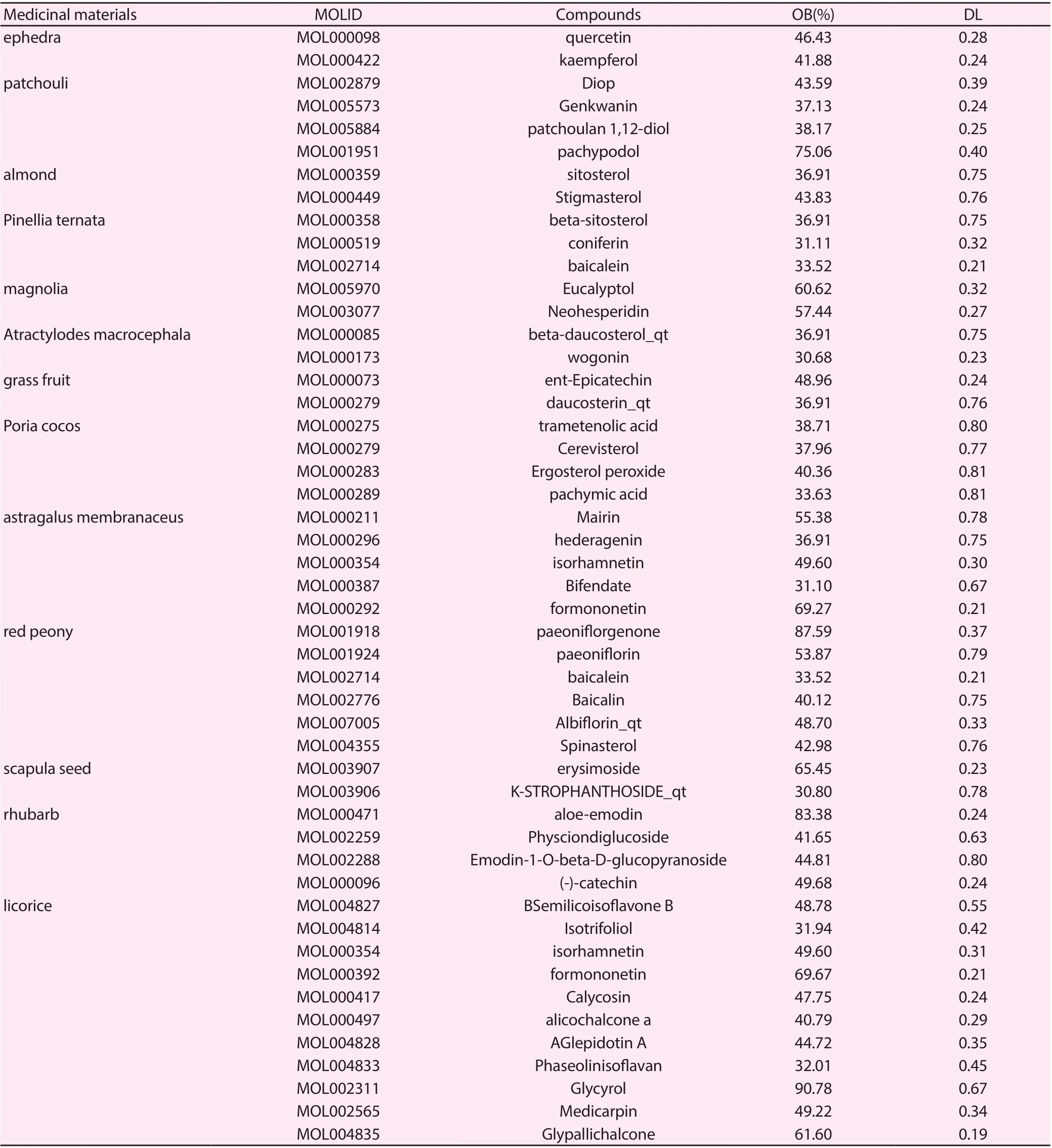
Table 1 Basic information of some compounds in Huashi Baidu Formula
3. Results
3.1 Screening of active components in Huashi Baidu prescription
A total of 1407 compounds from 13 medicinal materials (except raw gypsum) in Huashi Baidu prescription were searched by TCMSP database, including 230 from ephedra, 94 from patchouli, 85 from almond, 116 from Pinellia ternata, 139,139 from magnolia, 49 from Atractylodes macrocephala, 59 from grass fruit, 34 from Poria cocos, 87 from astragalus membranaceus, 75 from red peony, 67 from scapula seed, 92 from rhubarb and 280 from licorice. According to the standard of OB ≥ 30% and DL ≥ 0.18, a total of 245 active components were selected, including 6 from ephedra, 17 from patchouli, 8 from almond, 13 from Pinellia ternata, 2 from magnolia, 9 from Atractylodes, 8 from Poria, 20 from astragalus, 27 from red peony, 12 from scapula, 16 from rhubarb and 92 from licorice. The basic information of some compounds in Huashi Baidu prescription is shown in Table 1.
3.2 Construction of "drug-active ingredient-target" interaction network
The interaction network of "drug-active ingredient-target" in Huashi Baidu prescription is shown in figure 1. The green diamond represents the drug in the prescription of dampness and dampness, the pink triangle represents the active ingredient, and the orange arrow represents the target gene. The network has 338 nodes, including 13 drug nodes, 176 active component nodes and 149 target nodes, with a total of 3255 edges, of which 69 of the 245 active components did not participate in the construction of the network. Each edge in the network represents the active components contained in the drug and the interaction between the active components and the target genes, and the value of a node represents the number of routes connected to the nodes in the network. The "Networkanalyze" function in Cytoscape3.7.2 software is used to analyze the topological attributes of the network. Select the nodes with large (Degree) and center value (BetweennessCentrality,BC). These nodes play a pivotal role in the network and may be key compounds or targets. The average values of active components and targets in the network are 18.49 and 20.48 respectively. In terms of active components, 50% of the active components had more than 19 action targets. By analyzing the center value and grade value of active components-targets, it was found that the top 7 active compounds were MOL000098- quercetin, MOL000422- kaempferol, MOL000449- stigmasterol, MOL000354- isorhamnetin, MOL000173- baicalein, MOL000392- formononetin, MOL002714- baicalein, It can interact with 89, 56, 46, 35, 35, 35 and 32 target proteins, respectively. From the point of view of targets, a total of 35 targets could interact with 21 or more active components, and the top 10 were AR, ESR1, PTGS2, PPARG, NOS2, PIM1, DPP4, GSK3B, CDK2 and PTPN1, which could interact with 151,146,124,119,117,110,110,109,108 active components, respectively.
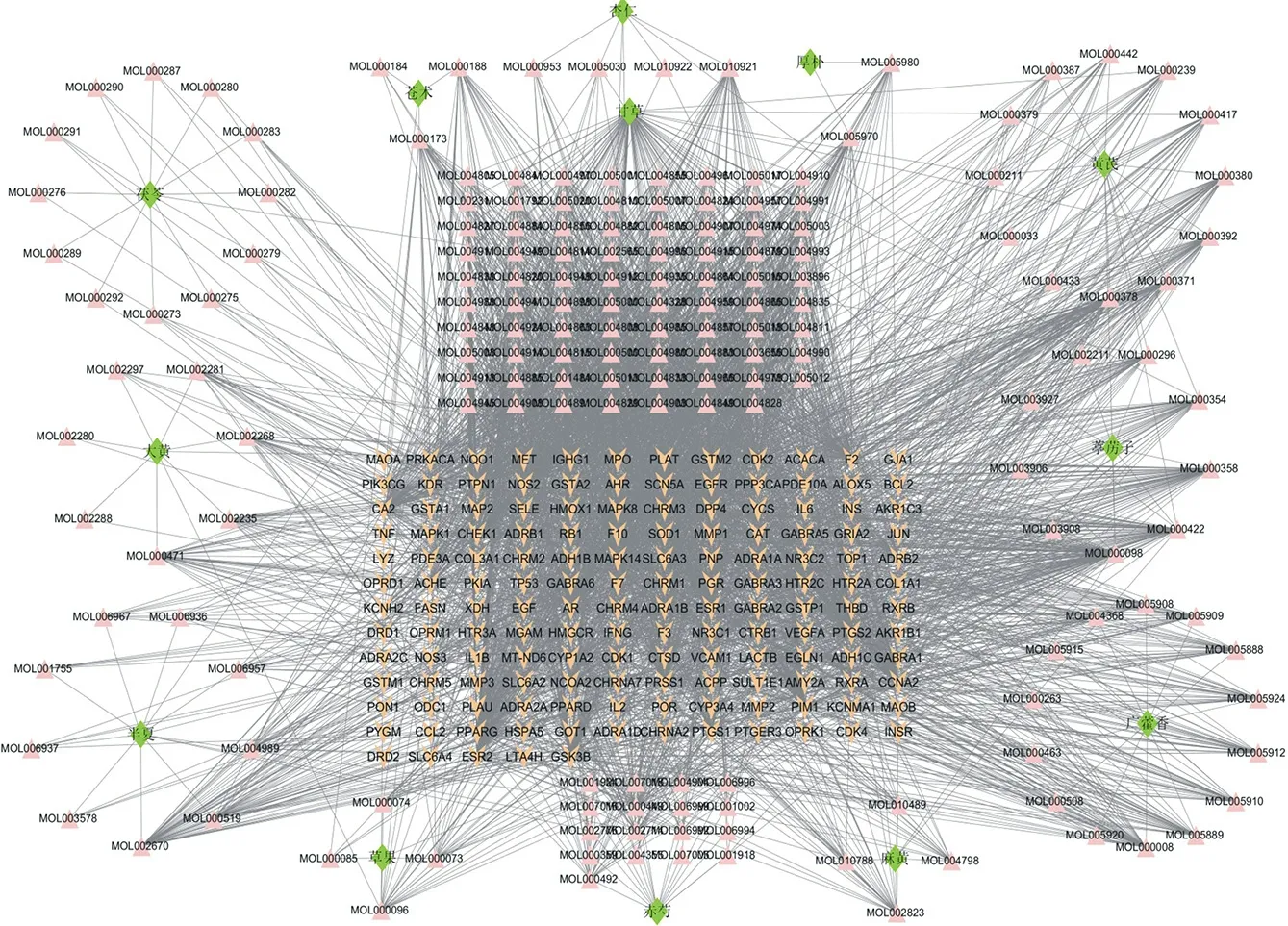
Fig.2“Drug -Component-Target”Network
3.3 Potential targets of Huashi Baidu recipe in the treatment of COVID-19
A total of 251 potential targets of COVID-19 were collected from GeneCards database. Use the Venny online platform (http://bioinformatics.psb.ugent.be/webtools/Venn/) to draw the Venny diagram, as shown in figure 2. The regulatory targets of Huashi Baidu prescription and the potential targets of COVID-19 were mapped and intersected, and a total of 26 cross targets were obtained, that is, the potential targets of Huashi Baidu prescription in the treatment of COVID-19.

Fig.3 Venn diagram of Huashi Baidu Formula and COVID-19 target
3.4 PPI Network and key targets
The PPI network and key nodes of the prescription for resolving dampness and detoxification are shown in figure 4. The network consists of 26 nodes and 214edges. The size and color of the nodes in the graph are positively correlated with the value. The larger the value, the darker the node is. Among them, the average node value is 15.85, and 10 key nodes (Hub nodes) in the network are screened out by "CytoHubba" plug-in, and the values are all greater than 16. It shows that these 10 target proteins are likely to be the key targets for Huashi Baidu prescription to exert its pharmacological action in the treatment of COVID-19. The specific information is shown in Table 2.
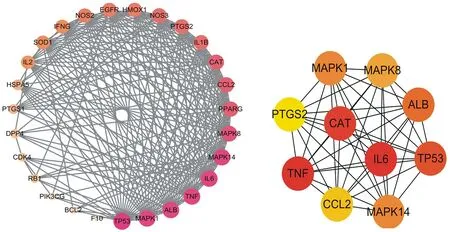
Fig. 4 PPI network diagram and key target diagram of Huashi Baidu Formula
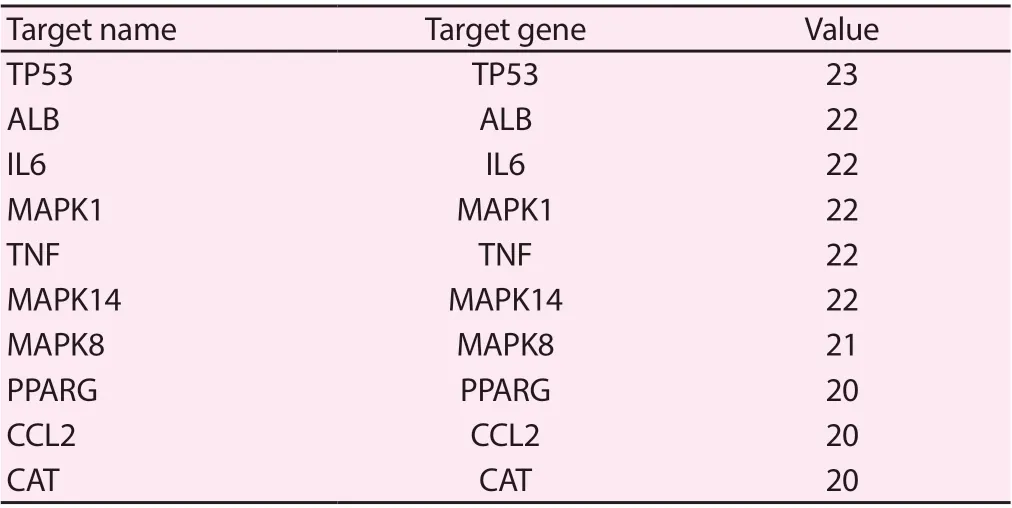
Table 2 key target information of Huashi Baidu Formula in the treatment of COVID-19
3.5 Target GO enrichment Analysis and KEGG Pathway Analysis
Through DAVID database analysis, a total of 234 GO enrichment items were obtained, including 179 biological processes (Biologicalprocesses,BP), 28 cellular functions (Molecularfunction,MF) and 27 cellular components (Cellcomposition,CC). Select the top 20 GO entries to draw the bubble chart, as shown in figure 5. BP is concentrated in active regulation of apoptosis process, active regulation of cell proliferation, inflammatory response, cell response to drugs, immune response, signal transduction and so on. The MF targets are mainly concentrated in protein binding, the same protein binding, enzyme binding, ATP binding, heme binding and cytokine activity.
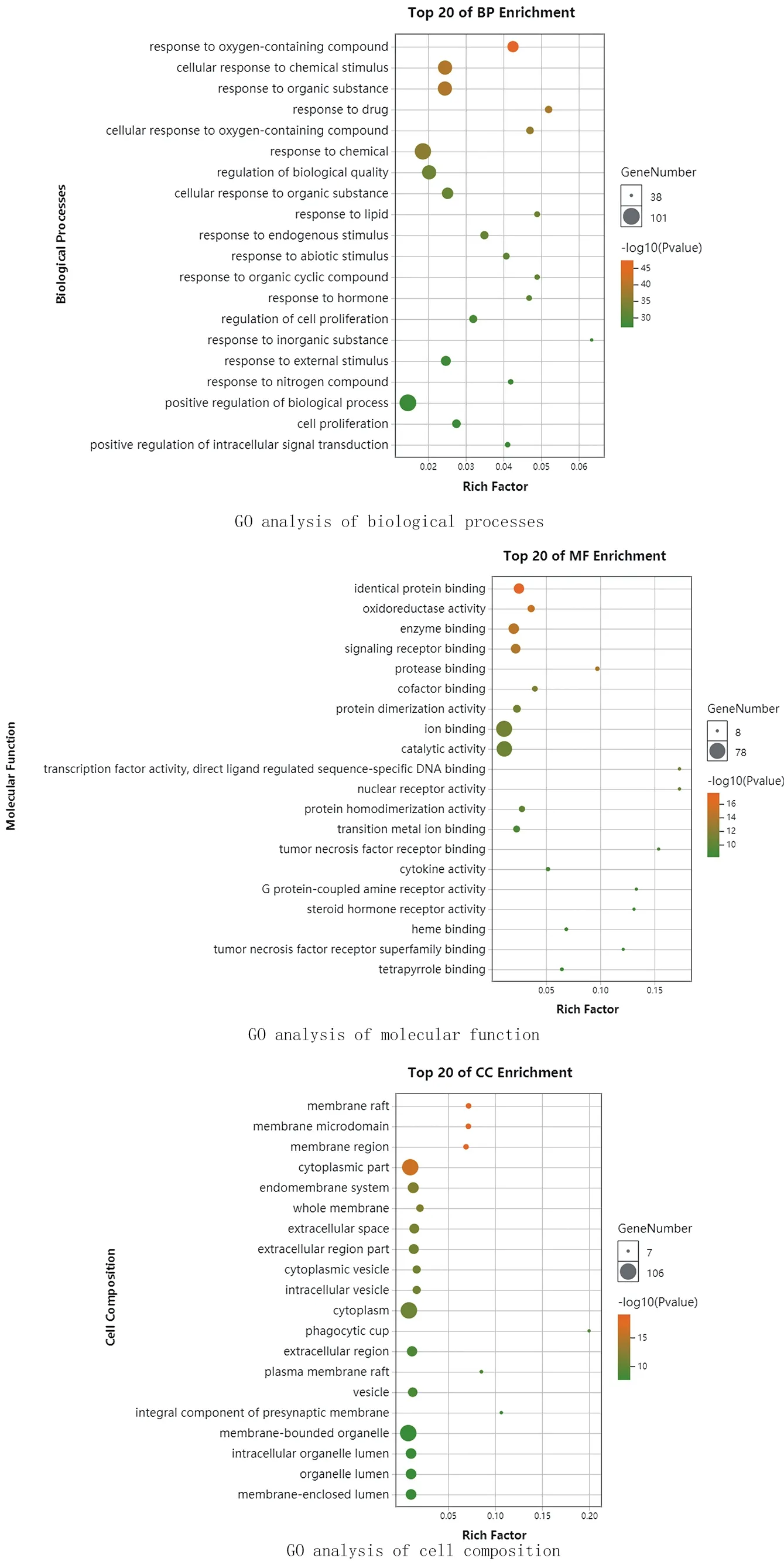
Fig.5 Enrichment analysis of target GO
82 signal pathways were screened by KEGG pathway enrichment analysis. The disease mainly involved small cell lung cancer ((Smallcelllungcancer)), non-small cell lung cancer (Nonsmallcelllungcancer), tuberculosis (Tuberculosis), pertussis (Pertussis) and so on. The biological pathway involved HIF-1 signal pathway, TNF signal pathway, PI3K-Akt signal pathway, NF- κB signal pathway, MAPK signal pathway and so on. The KEGG entries are classified and annotated according to the classification of pathways, and the first 20 pathways of enriching genes are selected to draw the bubble diagram, as shown in figure 6. The Y axis represents the name of the pathway, the X axis represents the percentage, the bubble area represents the number of genes enriched in the pathway, and the bubble color represents the size of the P value. According to the relationship between the protein target and the signal pathway, the key pathway is selected and the "targetpathway" network is established, as shown in figure 7, in which the green diamond represents the pathway and the brown circle represents the target.
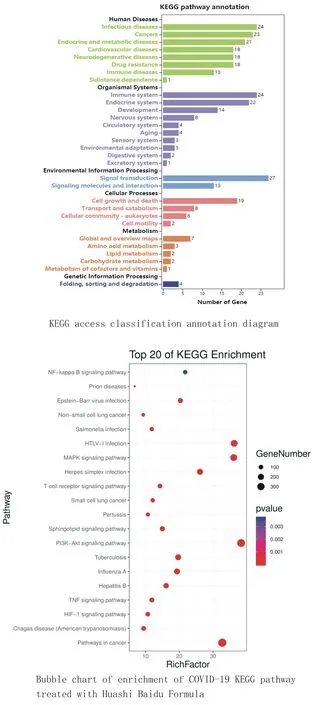
Fig.6 KEGG pathway analysis
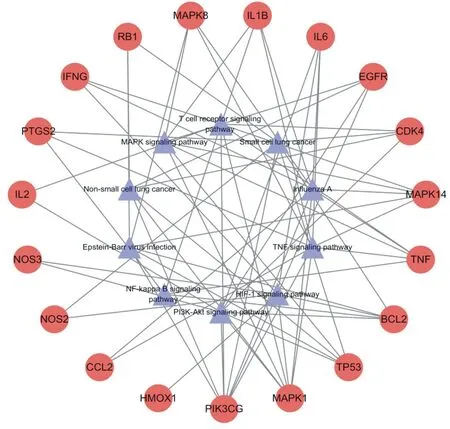
Fig.7 “Target-pathway” network
4. Discussion
The incubation period of COVID-19 was 1-14 days, mostly 3-7 days, with fever, fatigue and dry cough as the main manifestations. A few patients have symptoms such as stuffy nose, runny nose, sore throat and diarrhea. Most of the severe patients developed dyspnea and / or hypoxemia one week after the onset of the disease, and the severe cases developed rapidly into acute respiratory distress syndrome, septic shock, refractory metabolic acidosis and bleeding and coagulation dysfunction, resulting in death[7]. This disease belongs to the category of "epidemic disease" in traditional Chinese medicine. The disease is located in the lungs because of the feeling of "plague". As one of the recommended "three prescriptions and three drugs", Huashi Baidu prescription has achieved good curative effect in clinic. Among them, the heavy, light and common clinical efficacy observation and case accumulation were carried out in Jinyintan Hospital, East and West Lake Fang Hang Hospital and Jiangjun Street Community Health Center. Among them, as of March 20, the medical team of the Chinese Academy of traditional Chinese Medicine had treated a total of 146 patients in Jinyintan Hospital, 109 of which had been cured and discharged, with a discharge rate of 74.7%. The clinical efficacy of 894 cases of mild disease (452 cases of traditional Chinese medicine group) in Dongxihu Fang Cabin Hospital was observed, and the clinical observation results confirmed the effectiveness of Huashi Baidu prescription[8]. Animal experiments conducted by the Institute of Medical Experimental Animals of the Chinese Academy of Medical Sciences have confirmed that Huashi Baidu recipe can reduce the viral load in the lungs by 30%. The improvement of pulmonary inflammation also has a significant effect.
In this study, a total of 1407 compounds, 245 active components and 149 action targets were selected, including 26 potential targets for the treatment of COVID-19. Through screening, it was found that the key active components accounted for 50%, of which quercetin, kaempferol, stigmasterol, isorhamnetin, wogonin, formononetin and baicalein were the most significant. According to reports, quercetin has the effects of antioxidation and scavenging free radicals, as well as anti-inflammatory, antiviral, anti-tumor, hypoglycemic and immunomodulatory effects[11]. Wu et al.[12] found that quercetin could interact with the glycoprotein hemagglutinin 2 subunit of influenza virus, thus blocking the fusion of influenza virus. At the same time, it was also found that quercetin could inhibit the entry of H5N1 virus into cells by forging virus drug screening system, thus playing an antiviral role. In addition, quercetin may also improve pulmonary fibrosis by regulating S1P/SPHK signal pathway. Kaempferol also has a variety of pharmacological effects, such as anti-inflammatory, antibacterial, antioxidant, antiviral, enhancing immunity and so on[14]. Stigmasterol belongs to phytosterol, which has strong surface physiological activity. it can be antioxidant, antiinflammatory, immune regulation, regulation of mental status, anticancer and analgesia[15]; isorhamnetin has the effects of enhancing immune function, anti-inflammation, reducing blood lipid, antiatherosclerosis and so on[16]. Studies have shown that isorhamnetin can effectively block the nuclear expression of NF- κ B (p65), inhibit the degradation and phosphorylation of I κ B α in BV2 microglia stimulated by LPS, and then reduce the expression and production of pro-inflammatory mediators and cytokines by inhibiting NF- κ B pathway, thus achieving anti-inflammatory effect[17-18]. Both wogonin and baicalein have antiviral, antibacterial, anti-inflammatory, anti-tumor and fibrosis pharmacological effects, among which baicalein has a wide range of antiviral effects, including RNA virus and DNA virus[19]. It was found that the antiviral effect of baicalein at the dose of 960mg kg- 1 was better than that of ribavirin[20]. Wogonin can inhibit the activation of influenza virus on macrophages, thus inhibit the production of inflammation-related substances and reduce the overreaction of immune stress[20]. Formononetin is a kind of isoflavones, which plays a significant role in reducing inflammation, regulating immune mechanism and anti-tumor[21].
Through the analysis of the PPI network of Huashi Baidu recipe in the treatment of COVID-19, it is found that TP53, ALB, IL6, MAPK1, MAPK14, MAPK8, TNF, PPARD and other targets are the main targets of Huashi Baidu recipe in the treatment of COVID-19. Tumor necrosis protein p53 (TP53) is a cell cycle-related gene, which plays an important role in cell proliferation and apoptosis by regulating the synthesis of cell cycle-related proteins, and is considered to be a marker for predicting the efficacy or prognosis of lung cancer[22]. Albumin (ALB) is the most important protein in human plasma, which is usually considered to reflect the nutritional status of the whole body. It is involved in the stability of osmotic pressure and the protection of globulin. It is a non-specific transport protein. Interleukin-6 (IL-6) I is clinically recognized as a laboratory indicator for the diagnosis of pulmonary infection. It plays an important physiological role in transmitting information, activating and regulating immune cells in vivo. When the body is subjected to inflammation and infection, IL-6 stimulates the proliferation, differentiation and function of immune cells, and induces the production and release of CRP in the liver[23]. Studies have shown that overexpression of IL-6 in lung tissue cells and serum after infection with influenza A virus (H1N1) is an important cause of lung inflammation caused by influenza A virus[24]. MAPK1, MAPK14 and MAPK8 all belong to the family of mitogen-activated protein kinases (Mitogen-activatedProteinKinase,MAPK). The MAPK subfamily includes extracellular signal-regulated protein kinases (erk1/2), c-jun N-terminal kinases (jnk1/2) and p38. They are involved in cell proliferation, differentiation, apoptosis and inflammation, and are activated by diphosphate acidification[25]. Studies have shown that human cytomegalovirus (HCMV), HHV-8, EB virus, HIV, influenza virus and other virus infections are related to p38MAPK[26]. Tumor necrosis factor (TNF) is a pro-inflammatory factor, overexpression will lead to cytokine storm, make cytokine dysfunction, disrupt the immune balance, and thus aggravate the disease[27]. Peroxisome proliferator-activated receptor (PPARG) has a variety of biological effects. It not only regulates inflammation and immune response, but also plays an important role in glucose and lipid metabolism and maintenance of homeostasis[28]. In addition, the key sites of PPARD promoter region may play an important role in the epigenetic regulation of lung adenocarcinoma, which can promote the proliferation and metastasis of lung adenocarcinoma cells. Therefore, PPARD can also be used as a potential drug target for the treatment of lung cancer[29].
GO enrichment analysis shows that its biological processes are mainly involved in the regulation of apoptosis and cell proliferation, inflammatory reaction, cell response to drugs, immune response and so on. These biological processes play a key role in the treatment of COVID-19 by Huashi Baidu recipe. The results of KEGG pathway enrichment analysis are mainly related to small cell lung cancer, nonsmall cell lung cancer, tuberculosis, pertussis, HIF-1, TNF, PI3KAkt, NF- κ B, MAPK and other signal pathways, which play the role of antiviral, anti-inflammatory and immune regulation. Further analysis shows that whether the active components of MAPK1 and PIK3CG, Huashi Baidu recipe regulate the signal pathways of small cell lung cancer, non-small cell lung cancer, tuberculosis, pertussis, HIF-1, TNF, PI3K-Akt, NF- κ B and MAPK by acting on MAPK1 and PIK3CG targets need to be further studied. Hypoxia inducible factor-1 signal pathway (HIF-1) can inhibit pulmonary fibrosis by regulating inflammatory and immune response, inducing EMT and regulating ECM deposition[30]. MAPK pathway is ubiquitous in organisms, and the expression of p-ERK1/2, p-JNK1/2 and p-p38 is realized by phosphorylation of ERK1/2, JNK1/2 and p38, which are the main members of the MAPK subfamily. ERK signaling pathway plays an important role in acute lung injury by reducing the recruitment of pulmonary neutrophils in BALF and the release of inflammatory cytokines induced by lipopolysaccharide to reduce pulmonary inflammation and regulate cellular immunity.
To sum up, based on network pharmacology, this study takes Huashi Baidu prescription as the research object, analyzes its active components, action targets, biological processes and related pathways, and finds that the active components of Huashi Baidu prescription may regulate the immune response and inflammatory response of the body through key targets to treat COVID-19, is the result of the interaction of multi-components, multi-targets and multi-pathways. The purpose of this study is to provide a certain theoretical basis for the better application of Huashi Baidu recipe in clinic. However, it still has some limitations, and more in-depth research and experimental verification are needed.
杂志排行
Journal of Hainan Medical College的其它文章
- Experience of Professor Shao Mingxi in treating knee osteoarthritis based on "Bin Si Xue" acupuncture
- Effect of TGIF1 expression on epithelial cadherin and Twist1 protein expression in breast cancer cells
- Acupuncture for post-stroke dysphagia: An overview of systematic reviews
- Meta analysis of Masquelet technology and Llizarov technology in the treatment of infectious bone defects
- Establishment and evaluation of Type 2 Diabetes Mellitus andits complications induced by low dose of multiple streptozotocin
- A case of recurrent PMT caused by poor atrial pacing
